- الرئيسية
- معلومات عنا
- صناعة
- الخدمات
- قراءة
- اتصل بنا
سوق قرحة القدم السكرية: التحليل الحالي والتوقعات (2024-2032)
التركيز على النوع (قرحة اعتلال الأعصاب، قرحة إقفارية، وقرحة عصبية إقفارية)؛ العلاج (ضمادات العناية بالجروح، أجهزة العناية بالجروح، المواد البيولوجية، وغيرها)، المستخدمون النهائيون (المستشفيات، أماكن الرعاية المنزلية، وغيرها)؛ والمنطقة/البلد
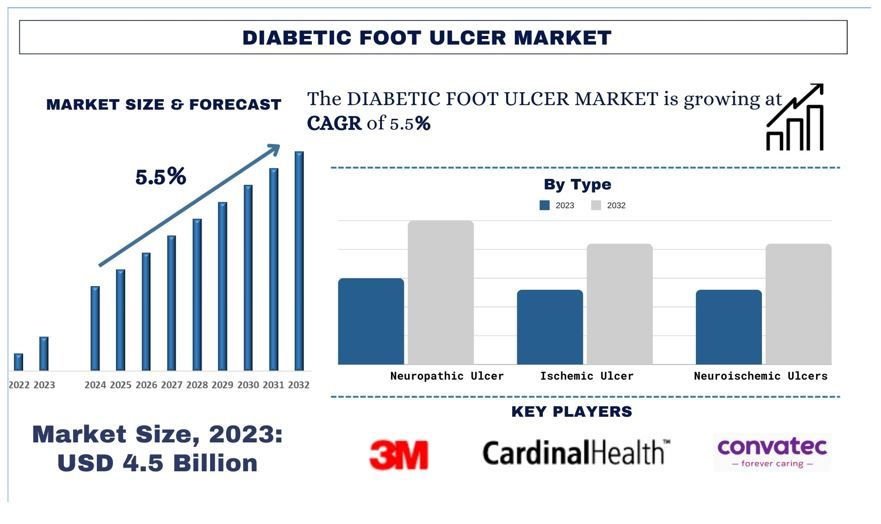 حجم سوق قرحة القدم السكرية والتوقعات
حجم سوق قرحة القدم السكرية والتوقعات
بلغت قيمة سوق قرحة القدم السكرية ما يقرب من 4.5 مليار دولار أمريكي في عام 2023 ومن المتوقع أن ينمو بمعدل نمو سنوي مركب قوي يبلغ حوالي 5.5٪ خلال الفترة المتوقعة (2024-2032) بسبب ارتفاع حالات الإصابة بمرض السكري.
تحليل سوق قرحة القدم السكرية
تعتبر قرحة القدم السكرية (DFU) من المضاعفات المزمنة الخطيرة لمرض السكري، حيث تصيب ما يقرب من 15٪ من جميع مرضى السكري خلال حياتهم. وهي تشكل عبئًا كبيرًا على المرضى وأنظمة الرعاية الصحية والمجتمع بسبب طبيعتها المزمنة ومعدلات تكرارها العالية واحتمال حدوث مضاعفات خطيرة، بما في ذلك بتر الأطراف السفلية. تشمل عوامل الخطر الأولية لقرحة القدم السكرية الاعتلال العصبي ومرض الشرايين المحيطية وتشوهات القدم والتقرح أو البتر السابق وضعف السيطرة على نسبة السكر في الدم والتدخين. يمكن أن تؤدي قرحة القدم السكرية إلى مضاعفات خطيرة، مثل التهاب العظم والنقي والغرغرينا وفي النهاية بتر الأطراف السفلية. يتم إجراء حوالي 50-70٪ من جميع عمليات بتر الأطراف السفلية في مرضى السكري.
على سبيل المثال، تفيد الجمعية الأمريكية للسكري (ADA) أن ما يقرب من 25٪ من الأشخاص المصابين بداء السكري سيصابون بقرحة في القدم في مرحلة ما من حياتهم.
على سبيل المثال، وفقًا لبيانات الاتحاد الدولي للسكري، يعيش حوالي 537 مليون بالغ (20-79 عامًا) مصابًا بداء السكري. ومن المتوقع أن يصل هذا العدد إلى 643 مليون بحلول عام 2030 و 783 مليون بحلول عام 2045.
على سبيل المثال، وفقًا لمنظمة الصحة العالمية (WHO)، من المتوقع أن تتضاعف نسبة الأشخاص الذين تبلغ أعمارهم 60 عامًا أو أكثر تقريبًا من 12٪ إلى 22٪ بين عامي 2015 و 2050.
اتجاهات سوق قرحة القدم السكرية
يناقش هذا القسم اتجاهات السوق الرئيسية التي تؤثر على مختلف قطاعات سوق قرحة القدم السكرية كما حددها فريق خبراء الأبحاث لدينا.
تزايد الطلب على الضمادات الذكية وأجهزة العناية بالجروح
أصبحت تقنيات العناية بالجروح المتقدمة مثل الضمادات الذكية، التي يمكنها مراقبة بيئة الجرح (مثل الأس الهيدروجيني ودرجة الحرارة ومستويات الرطوبة)، أكثر شيوعًا. يمكن أن توفر هذه الضمادات بيانات في الوقت الفعلي لمقدمي الرعاية الصحية، مما يسمح بإدارة الجروح بشكل أكثر دقة وتدخل أسرع إذا لزم الأمر. علاوة على ذلك، يتم دمج أجهزة الاستشعار القابلة للارتداء وأجهزة المراقبة عن بعد في العناية بالقدم السكرية. يمكن لهذه الأجهزة تتبع معلمات مثل درجة الحرارة والضغط وتشوهات المشية، مما يوفر مراقبة مستمرة لصحة القدم. يمكن أن يساعد هذا الكشف المبكر في منع تطور القرح أو تفاقمها.
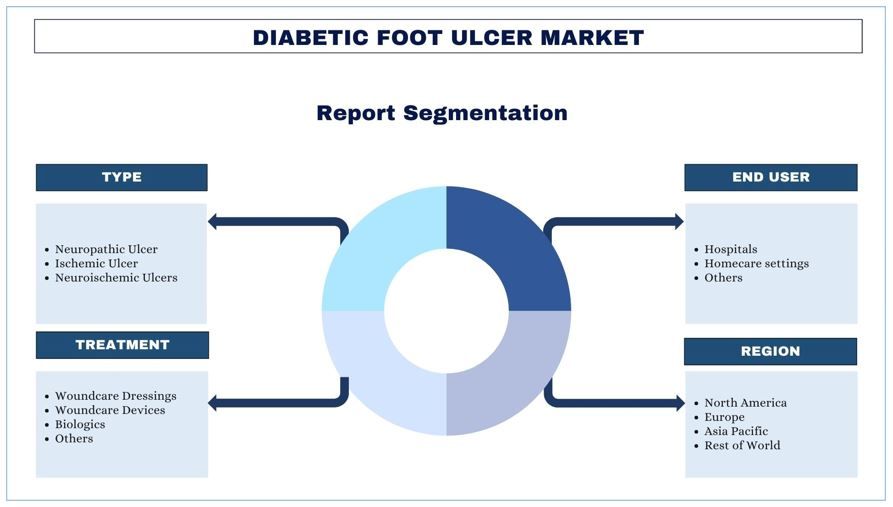
من المتوقع أن تنمو أمريكا الشمالية بمعدل نمو سنوي مركب كبير خلال الفترة المتوقعة
شهد سوق قرحة القدم السكرية في أمريكا الشمالية نموًا كبيرًا في السنوات الأخيرة، مدفوعًا بعوامل مختلفة. تمثل أمريكا الشمالية، وخاصة الولايات المتحدة، أحد أكبر الأسواق لقرحة القدم السكرية على مستوى العالم. أحد المحركات الرئيسية لسوق قرحة القدم السكرية في أمريكا الشمالية هو تزايد حالات الإصابة بمرض السكري والتقدم في التكنولوجيا. على سبيل المثال، وفقًا لبيانات الاتحاد الدولي للسكري (IDF)، يعيش 51 مليون حالة من البالغين مصابين بداء السكري في أمريكا الشمالية في عام 2021.
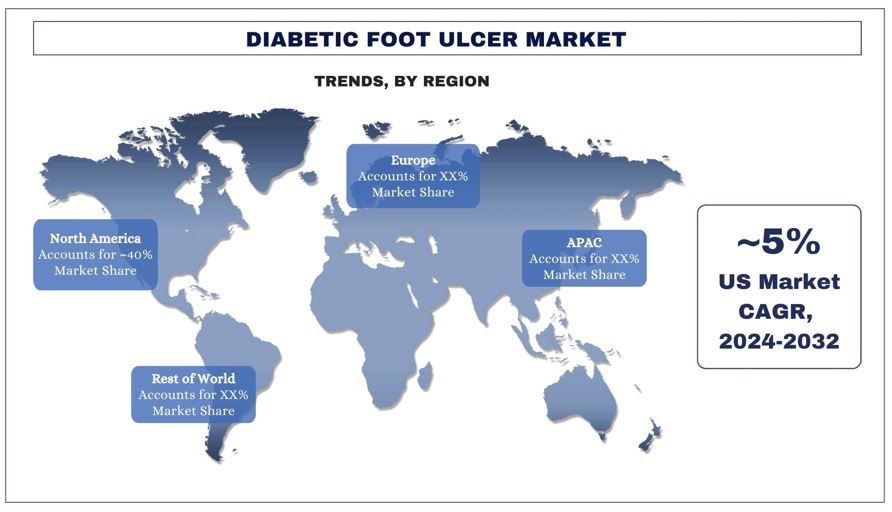
نظرة عامة على صناعة قرحة القدم السكرية
سوق قرحة القدم السكرية تنافسي، مع وجود العديد من اللاعبين في السوق العالميين والدوليين. يتبنى اللاعبون الرئيسيون استراتيجيات نمو مختلفة لتعزيز وجودهم في السوق، مثل الشراكات والاتفاقيات والتعاون وإطلاق المنتجات الجديدة والتوسعات الجغرافية وعمليات الاندماج والاستحواذ. بعض اللاعبين الرئيسيين العاملين في السوق هم 3M Company و ConvaTec Group plc و Cardinal Health Inc. و B. Braun SE و Molnlycke Health Care AB و Smith and Nephew plc و Essity Aktiebolag AB و ORGANOGENESIS HOLDINGS INC. و Integra LifeSciences Holdings Corporation و Coloplast.
تغطية تقرير سوق قرحة القدم السكرية
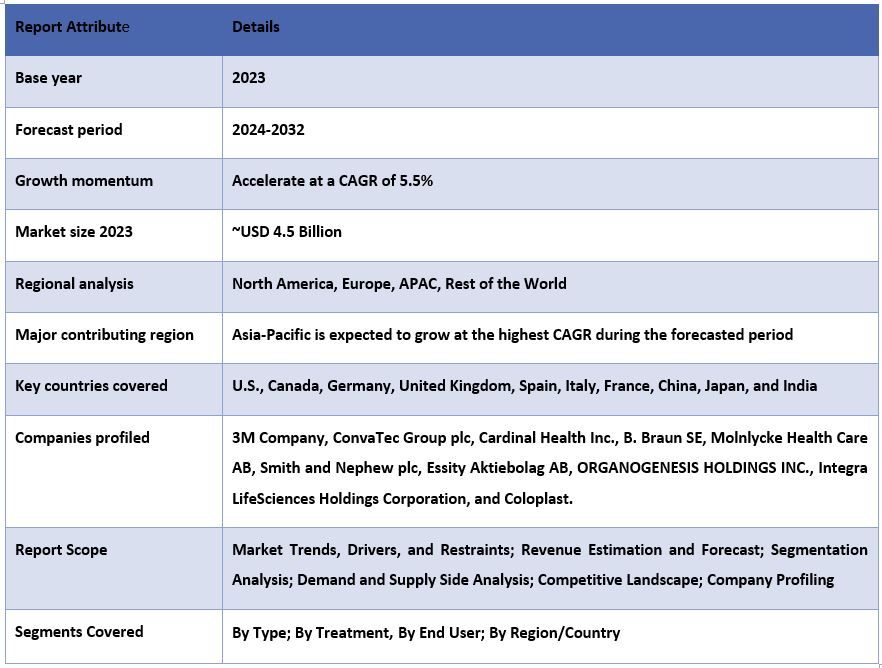
أسباب شراء هذا التقرير:
- تتضمن الدراسة قياس حجم السوق وتحليل التنبؤات الذي تم التحقق منه من قبل خبراء الصناعة الرئيسيين الموثوقين.
- يقدم التقرير مراجعة سريعة للأداء العام للصناعة في لمحة واحدة.
- يغطي التقرير تحليلًا متعمقًا لأقران الصناعة البارزين مع التركيز الأساسي على البيانات المالية الرئيسية للأعمال ومحافظ المنتجات واستراتيجيات التوسع والتطورات الأخيرة.
- فحص مفصل للدوافع والقيود والاتجاهات الرئيسية والفرص السائدة في الصناعة.
- تغطي الدراسة السوق بشكل شامل عبر قطاعات مختلفة.
- تحليل متعمق على المستوى الإقليمي للصناعة.
خيارات التخصيص:
يمكن تخصيص سوق قرحة القدم السكرية العالمي بشكل أكبر وفقًا للمتطلبات أو أي قطاع سوق آخر. إلى جانب ذلك، تتفهم UMI أن لديك احتياجات عمل خاصة بك، لذا لا تتردد في التواصل معنا للحصول على تقرير يناسب متطلباتك تمامًا.
جدول المحتويات
منهجية البحث لتحليل سوق قرحة القدم السكري (2024-2032)
كان تحليل السوق التاريخي وتقدير السوق الحالي والتنبؤ بسوق قرحة القدم السكري العالمي المستقبلي هي الخطوات الرئيسية الثلاث التي تم اتخاذها لإنشاء وتحليل اعتماد قرحة القدم السكري في المناطق الرئيسية على مستوى العالم. تم إجراء بحث ثانوي شامل لجمع أرقام السوق التاريخية وتقدير حجم السوق الحالي. ثانيًا، للتحقق من صحة هذه الرؤى، تم أخذ العديد من النتائج والافتراضات في الاعتبار. علاوة على ذلك، تم إجراء مقابلات أولية شاملة أيضًا مع خبراء الصناعة عبر سلسلة القيمة لسوق قرحة القدم السكري العالمي. بعد الافتراض والتحقق من صحة أرقام السوق من خلال المقابلات الأولية، استخدمنا منهجًا من أعلى إلى أسفل / من أسفل إلى أعلى للتنبؤ بحجم السوق الكامل. بعد ذلك، تم اعتماد طرق تقسيم السوق وتثليث البيانات لتقدير وتحليل حجم سوق القطاعات والقطاعات الفرعية ذات الصلة بالصناعة. تم شرح المنهجية التفصيلية أدناه:
تحليل حجم السوق التاريخي
الخطوة 1: دراسة متعمقة للمصادر الثانوية:
تم إجراء دراسة ثانوية تفصيلية للحصول على حجم السوق التاريخي لسوق قرحة القدم السكري من خلال مصادر الشركة الداخلية مثل التقارير السنوية والبيانات المالية وعروض الأداء والنشرات الصحفية وما إلى ذلك، والمصادر الخارجية بما في ذلك المجلات والأخبار والمقالات والمنشورات الحكومية ومنشورات المنافسين وتقارير القطاعات وقاعدة بيانات الطرف الثالث والمنشورات الموثوقة الأخرى.
الخطوة 2: تجزئة السوق:
بعد الحصول على حجم السوق التاريخي لسوق قرحة القدم السكري، أجرينا تحليلًا ثانويًا تفصيليًا لجمع رؤى السوق التاريخية وحصتها للقطاعات والقطاعات الفرعية المختلفة للمناطق الرئيسية. يتم تضمين القطاعات الرئيسية في التقرير كنوع وعلاج ومستخدم نهائي ومناطق. علاوة على ذلك، تم إجراء تحليلات على مستوى الدولة لتقييم الاعتماد العام لنماذج الاختبار في تلك المنطقة.
الخطوة 3: تحليل العوامل:
بعد الحصول على حجم السوق التاريخي للقطاعات والقطاعات الفرعية المختلفة، أجرينا تحليلًا تفصيليًا للعوامل لتقدير حجم السوق الحالي لسوق قرحة القدم السكري. علاوة على ذلك، أجرينا تحليلًا للعوامل باستخدام متغيرات تابعة ومستقلة مثل النوع والعلاج والمستخدم النهائي والمناطق الخاصة بسوق قرحة القدم السكري. تم إجراء تحليل شامل لسيناريوهات جانب الطلب والعرض مع الأخذ في الاعتبار أهم الشراكات وعمليات الدمج والاستحواذ والتوسع التجاري وإطلاق المنتجات في قطاع سوق قرحة القدم السكري في جميع أنحاء العالم.
تقدير حجم السوق الحالي والتنبؤ به
تحديد حجم السوق الحالي: بناءً على رؤى قابلة للتنفيذ من الخطوات الثلاث المذكورة أعلاه، توصلنا إلى حجم السوق الحالي واللاعبين الرئيسيين في سوق قرحة القدم السكري العالمي والحصص السوقية للقطاعات. تم تحديد جميع تقسيمات الحصص المئوية المطلوبة وتقسيمات السوق باستخدام النهج الثانوي المذكور أعلاه وتم التحقق منها من خلال المقابلات الأولية.
التقدير والتنبؤ: لتقدير السوق والتنبؤ به، تم تعيين أوزان لعوامل مختلفة بما في ذلك المحركات والاتجاهات والقيود والفرص المتاحة لأصحاب المصلحة. بعد تحليل هذه العوامل، تم تطبيق تقنيات التنبؤ ذات الصلة، أي النهج من أعلى إلى أسفل / من أسفل إلى أعلى للوصول إلى توقعات السوق لعام 2032 للقطاعات والقطاعات الفرعية المختلفة عبر الأسواق الرئيسية على مستوى العالم. تتضمن منهجية البحث المعتمدة لتقدير حجم السوق ما يلي:
- حجم سوق الصناعة، من حيث الإيرادات (بالدولار الأمريكي) ومعدل اعتماد سوق قرحة القدم السكري عبر الأسواق الرئيسية محليًا
- جميع الحصص المئوية والانقسامات والتقسيمات الفرعية لقطاعات السوق والقطاعات الفرعية
- اللاعبون الرئيسيون في سوق قرحة القدم السكري العالمي من حيث المنتجات المعروضة. أيضًا، استراتيجيات النمو التي يتبناها هؤلاء اللاعبون للتنافس في السوق سريع النمو.
التحقق من صحة حجم السوق والحصة السوقية
البحث الأولي: تم إجراء مقابلات متعمقة مع قادة الرأي الرئيسيين (KOLs) بما في ذلك كبار المديرين التنفيذيين (CXO / VPs، ورئيس المبيعات، ورئيس التسويق، ورئيس العمليات، والرئيس الإقليمي، والرئيس القطري، وما إلى ذلك) عبر المناطق الرئيسية. تم بعد ذلك تلخيص نتائج البحث الأولي وإجراء تحليل إحصائي لإثبات الفرضية المذكورة. تم دمج المدخلات من البحث الأولي مع النتائج الثانوية، وبالتالي تحويل المعلومات إلى رؤى قابلة للتنفيذ.
تقسيم المشاركين الأساسيين في مناطق مختلفة
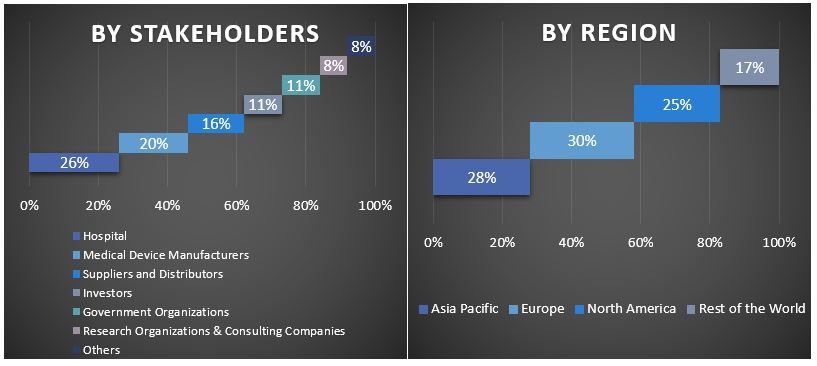
هندسة السوق
تم استخدام تقنية تثليث البيانات لإكمال تقدير السوق الإجمالي والوصول إلى أرقام إحصائية دقيقة لكل قطاع وقطاع فرعي من سوق قرحة القدم السكري العالمي. تم تقسيم البيانات إلى عدة قطاعات وقطاعات فرعية بعد دراسة المعلمات والاتجاهات المختلفة في مجالات النوع والعلاج والمستخدم النهائي والمناطق في سوق قرحة القدم السكري العالمي.
الهدف الرئيسي لدراسة سوق قرحة القدم السكري العالمي
تم تحديد اتجاهات السوق الحالية والمستقبلية لسوق قرحة القدم السكري العالمي في الدراسة. يمكن للمستثمرين الحصول على رؤى استراتيجية لأساس تقديرهم للاستثمارات على التحليل النوعي والكمي الذي تم إجراؤه في الدراسة. حددت اتجاهات السوق الحالية والمستقبلية الجاذبية الإجمالية للسوق على المستوى الإقليمي، مما يوفر منصة للمشارك الصناعي لاستغلال السوق غير المستغل للاستفادة من ميزة المحرك الأول. تشمل الأهداف الكمية الأخرى للدراسات ما يلي:
- تحليل حجم السوق الحالي والمتوقع لسوق قرحة القدم السكري من حيث القيمة (بالدولار الأمريكي). أيضًا، قم بتحليل حجم السوق الحالي والمتوقع للقطاعات والقطاعات الفرعية المختلفة.
- تشمل القطاعات في الدراسة مجالات النوع والعلاج والمستخدم النهائي والمناطق.
- تحديد وتحليل الإطار التنظيمي لقرحة القدم السكري
- تحليل سلسلة القيمة المعنية بوجود وسطاء مختلفين، إلى جانب تحليل سلوكيات العملاء والمنافسين في الصناعة.
- تحليل حجم السوق الحالي والمتوقع لسوق قرحة القدم السكري للمنطقة الرئيسية.
- تشمل الدول الرئيسية في المناطق التي تمت دراستها في التقرير منطقة آسيا والمحيط الهادئ وأوروبا وأمريكا الشمالية وبقية العالم
- ملفات تعريف شركات سوق قرحة القدم السكري واستراتيجيات النمو التي يتبناها اللاعبون في السوق للاستمرار في السوق سريع النمو.
- تحليل إقليمي متعمق للصناعة
الأسئلة الشائعة الأسئلة الشائعة
س1: ما هو حجم السوق الحالي لسوق قرحة القدم السكرية وإمكانات النمو؟
س2: ما هي العوامل الدافعة لنمو سوق قرحة القدم السكري؟
س3: أي قطاع لديه الحصة الأكبر من سوق قرحة القدم السكري حسب النوع؟
س4: ما هي التقنيات والاتجاهات الناشئة في سوق قرحة القدم السكري؟
س5: أي منطقة ستهيمن على سوق قرحة القدم السكرية؟
ذات صلة التقارير
العملاء الذين اشتروا هذا المنتج اشتروا أيضًا










